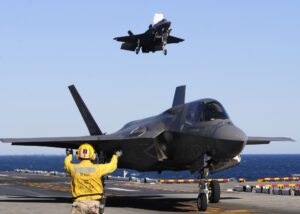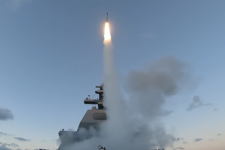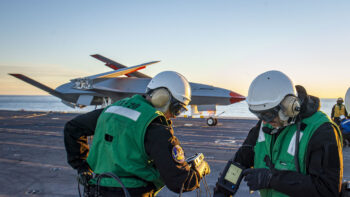
A Marine F-35B in vertical landing mode.
WASHINGTON: The first variant of the most expensive conventional weapons program ever is now officially ready for combat. In one of his last acts as Marine Corps Commandant, future Joint Chiefs Chairman Gen. Joseph Dunford announced today that the Marine model of the Joint Strike Fighter, the F-35B vertical take-off and landing (VTOL) version, has achieved Initial Operational Capability (IOC).
Don’t expect the F-35B to go to war right away, however. The deputy Commandant for aviation, Lt. Gen. Jon Davis, has made clear he first wants to build up the single squadron of 10 planes now based in Yuma, Arizona and get a deeper bench of personnel beyond the current 50 pilots and 500 maintainers. The next squadron to switch to F-35Bs will do so next year, followed by the third squadron in 2018. It’s worth noting that the F-35’s big brother, the F-22 –also a Lockheed product — achieved IOC in 2005 and didn’t fire its first shot in anger until last fall, against the Islamic State. Of course, the F-22 is best suited to air to air matches, while the F-35 is a strike fighter, designed for Close Air Support and other ground-related missions.

F-35Bs operating off the USS Wasp
The long-awaited decision is “a significant milestone in the continued evolution of the F-35 Joint Strike Fighter program,” Pentagon procurement chief Frank Kendall said in a statement. “This accomplishment is an affirmation that the F-35 program is on track…It is also a reminder that we still have work ahead to deliver the full warfighting capability required by all three services and our [international] partners while we continue our successful efforts to drive cost out of the program.”
Of all those prospective F-35 users in the US military and abroad, it’s the Marine Corps that has been most committed to the program. That commitment to make the Joint Strike Fighter work is comparable to the Marines’ passion for the once equally troubled V-22 Osprey. Indeed, the service bet the farm on F-35B, retaining aging ’80s aircraft that are now falling apart instead of buying new planes continuously as the Navy has. So today’s decision is no surprise, despite anxieties about last-minute glitches.
In its final tests, Lt. Gen. Davis announced, “the squadron’s aircraft performed well in all five IOC operational scenarios: Close Air Support, Air Interdiction, Armed Reconnaissance, Offensive Counter Air and Defensive Counter Air. This included live ordnance deliveries. ” The F-35B will ultimately take on even more missions, such as jamming, and replace three different aircraft: the AV-8B Harrier jump jet, the F/A-18 Hornet fighter, and the EA-6B Prowler electronic warfare plane.
The Air Force’s F-35A version is the next scheduled for IOC, in December 2016. The Navy’s F-35C comes last, in 2019.
Colin contributed to this piece.
Lockheed wins competition to build next-gen interceptor
The Missile Defense Agency recently accelerated plans to pick a winning vendor, a decision previously planned for next year.


























